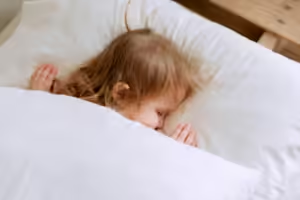The Sleep Solution Hiding in Plain Sight: Unraveling the Myths and Exploring the Potential of Melatonin for Children with Occasional Sleeplessness
Sleep. The very word conjures images of peaceful slumber, of bodies and minds rejuvenating, preparing for another day. But for many parents, the reality of their child’s sleep is far from this tranquil picture. Sleeplessness in children is incredibly common, with a recent study suggesting as many as 25% of children will experience a sleep problem at some point. This isn’t just about tired children and frustrated parents; inadequate sleep can have a ripple effect, impacting a child’s physical health, mental well-being, and cognitive development.
This article delves into the findings of a recent groundbreaking research paper, “Myths and Evidence Regarding Melatonin Supplementation for Occasional Sleeplessness in the Pediatric Population,” published in Pediatric Annals in 2021 by Goldman et al. This paper sheds light on a potential solution hiding in plain sight: melatonin. Long shrouded in misconceptions and unwarranted fears, melatonin is stepping out of the shadows as a safe and potentially effective tool for managing sleeplessness in children.
The study, driven by a consensus panel of leading academics and clinicians, aimed to cut through the noise and provide clear, evidence-based guidance on using melatonin for occasional sleeplessness in children. Their findings are revolutionizing how we approach sleep problems in young people, offering hope to families struggling with the nightly battle of getting their children to sleep.
Unveiling the Science of Sleep and the Role of Melatonin
Before we dive into the specifics of the study, let’s take a brief journey into the fascinating world of sleep science. You see, sleep isn’t simply about closing your eyes and drifting off; it’s a carefully orchestrated dance between our internal body clock and the environment.
This internal clock, known as the circadian rhythm, is primarily governed by the suprachiasmatic nucleus (SCN) – a tiny, powerful region in the brain that acts like a conductor, keeping our sleep-wake cycle in sync with the rhythms of day and night. But the SCN doesn’t work alone. It relies on a vital messenger, a hormone called melatonin, produced by the pineal gland in our brain.
As darkness descends, melatonin levels rise, signaling to our body that it’s time to wind down and prepare for sleep. It’s melatonin that helps regulate our sleep-wake cycle, promoting sleep onset and contributing to a restful night.
The Rise of Melatonin: Addressing a Growing Need
Over the past decade, melatonin use in children has skyrocketed, increasing sevenfold between 2007 and 2012 alone. This surge in popularity isn’t surprising. Parents, desperate for solutions to their children’s sleep woes, are increasingly turning to melatonin as a beacon of hope.
But alongside its rising popularity came a wave of misinformation and unfounded fears. Some worried about the potential for delayed puberty, while others fretted about the impact on a child’s natural melatonin production. These concerns, while understandable, lacked scientific grounding. This is where the 2021 study by Goldman et al. comes in, providing much-needed clarity based on rigorous scientific evidence.
Delving into the Research: Melatonin’s Efficacy in Children
The researchers meticulously analyzed a range of studies exploring melatonin’s effectiveness in children with sleep issues. Their findings were striking, consistently demonstrating melatonin’s potential to improve sleep in children.
One compelling study focused on teenagers aged 14-19 grappling with sleep-onset difficulties. These students, given 1 mg of melatonin in the late afternoon or early evening, experienced significantly improved sleep. They fell asleep quicker, enjoyed longer sleep, and even reported feeling less sleepy during the day. Imagine, teenagers waking up refreshed and alert – a concept almost unheard of!
Another study, this time focusing on younger children aged 6-12 with chronic sleep-onset insomnia (CSOI), painted a similarly positive picture. These children, after receiving 5 mg of melatonin for just four weeks, experienced a remarkable improvement in their sleep patterns. They fell asleep faster, woke up less frequently during the night, and enjoyed increased total sleep time.
Perhaps most tellingly, a long-term follow-up study demonstrated the sustained benefits of melatonin over time. Children who continued melatonin treatment for approximately three years continued to experience improved sleep without any adverse effects on their development or growth.
Putting the Fears to Rest: Melatonin’s Safety Profile in Children
The safety of any medication or supplement given to children is paramount, and melatonin is no exception. The researchers addressed this concern head-on, systematically reviewing numerous studies to assess melatonin’s safety profile in children.
Their conclusion? Melatonin, when used in recommended dosages, boasts a favorable safety profile with minimal side effects. The most commonly reported side effects, such as fatigue or drowsiness, were generally mild and transient. Importantly, the long-held fears regarding delayed puberty or suppression of natural melatonin production were debunked. Rigorous scientific evidence simply doesn’t support these claims.
However, the study emphasized a crucial point: not all melatonin is created equal. The quality of melatonin supplements can vary drastically, with some products containing significantly more or less melatonin than stated on the label. Some even contain traces of serotonin, a neurotransmitter that, in high levels, can be associated with certain neurological conditions.
This highlights the crucial need to prioritize high-quality melatonin supplements from reputable manufacturers. As with any medication, consulting with a healthcare professional before starting your child on melatonin is always recommended.
From Evidence to Action: A Framework for Managing Sleeplessness in Children
The study’s findings are not just about validating the use of melatonin; they provide a clear, actionable framework for managing occasional sleeplessness in children.
Imagine this: You’re a parent concerned about your child’s sleep. They’re struggling to fall asleep, waking up frequently, and are exhausted during the day. You take them to their pediatrician, who, armed with the latest evidence-based guidelines, recommends a stepwise approach:
Step 1: Assessment and Education
The first step involves a thorough evaluation of your child’s sleep patterns, using tools like sleep diaries to track their sleep-wake cycles. This helps rule out any underlying medical or psychological conditions that might be contributing to their sleep difficulties.
The next step involves empowering parents with knowledge. You’ll receive education about sleep hygiene – those simple yet powerful lifestyle modifications that can significantly impact sleep. Think consistent bedtime routines, limiting daytime naps, and creating a calm and relaxing sleep environment.
Step 2: Sleep Hygiene and Family Education
You leave the doctor’s office armed with a personalized sleep plan and a newfound understanding of sleep’s importance. You diligently implement the recommended sleep hygiene practices, creating a consistent and calming bedtime routine. You limit screen time in the hours before bed and ensure your child’s bedroom is conducive to sleep – dark, quiet, and cool.
Step 3: Considering Melatonin
You meticulously follow the recommendations, but despite your best efforts, your child continues to struggle with sleep. This is where melatonin enters the picture. After carefully considering the potential benefits and risks, and under the guidance of your child’s healthcare provider, you decide to try a high-quality melatonin supplement.
Step 4: Melatonin with or without Cognitive Behavioral Therapy (CBT)
In some cases, a healthcare professional may recommend incorporating Cognitive Behavioral Therapy for Insomnia (CBT-I). This therapy helps identify and modify thoughts and behaviors that interfere with sleep, equipping children with long-term tools to manage their sleep challenges.
Step 5: Consultation with Sleep Specialist
If the above approaches are insufficient, the family may be referred to a sleep specialist for further evaluation and treatment recommendations.
This framework, grounded in the latest scientific evidence, empowers parents and healthcare providers to work together, addressing sleeplessness in children proactively and effectively.
Melatonin: Not a Magic Bullet, but a Powerful Tool
It’s crucial to remember that melatonin is not a magical cure-all for sleeplessness. It’s not about simply giving a child a pill and expecting instant results. Instead, it’s about integrating melatonin as part of a comprehensive approach to sleep management.
Think of melatonin as a powerful tool in a toolbox, used strategically alongside other essential tools – sleep hygiene, family education, and in some cases, cognitive behavioral therapy. When used in this way, melatonin has the potential to transform the lives of children struggling to get a good night’s sleep.
The Future of Children’s Sleep: Embracing Evidence-Based Solutions
The 2021 study by Goldman et al. marks a turning point in how we understand and manage sleeplessness in children. It challenges outdated misconceptions and paves the way for a more open and evidence-based approach to using melatonin.
As we move forward, it’s crucial to continue this momentum, promoting ongoing research, education, and open communication between healthcare providers, parents, and children. By embracing evidence-based solutions and fostering a deeper understanding of sleep’s vital importance, we can help children everywhere unlock the power of restful sleep.
We’ve explored the science, dissected the research, and unraveled the myths surrounding melatonin. Now, let me ask you, as parents, caregivers, and advocates for children’s well-being: Are we ready to rewrite the narrative around children’s sleep and embrace the full potential of melatonin as a safe and effective tool for a brighter, more well-rested future?








